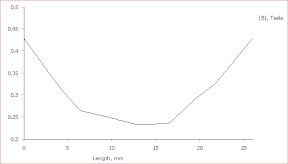I have been inspired from this tread in a Danish site:HIFI4ALL Forum: Lyd laboratoriet
And have made this one:
![URL]](/community/proxy.php?image=http%3A%2F%2F%5BURL%3Dhttp%3A%2F%2Fimg834.imageshack.us%2Fi%2Fdsc02085nd.jpg%2F%5D%5BIMGDEAD%5Dhttp%3A%2F%2Fimg834.imageshack.us%2Fimg834%2F4369%2Fdsc02085nd.jpg%5B%2FIMGDEAD%5D%5B%2FURL%5D&hash=b0d94fa7de25dbb952090e88aae8ae94)
My second attempt:
![URL]](/community/proxy.php?image=http%3A%2F%2F%5BURL%3Dhttp%3A%2F%2Fimg827.imageshack.us%2Fi%2F0012tdd.jpg%2F%5D%5BIMGDEAD%5Dhttp%3A%2F%2Fimg827.imageshack.us%2Fimg827%2F332%2F0012tdd.jpg%5B%2FIMGDEAD%5D%5B%2FURL%5D&hash=14aa8fc3a2d85e3926a3d33561eb6416)
![URL]](/community/proxy.php?image=http%3A%2F%2F%5BURL%3Dhttp%3A%2F%2Fimg840.imageshack.us%2Fi%2Fdsc02073l.jpg%2F%5D%5BIMGDEAD%5Dhttp%3A%2F%2Fimg840.imageshack.us%2Fimg840%2F531%2Fdsc02073l.jpg%5B%2FIMGDEAD%5D%5B%2FURL%5D&hash=eb9921cc2b80574ef08bec76f31861b0)
Here how the magnets are placed on two 10x10mm.square iron.
More later.
Bernt
And have made this one:
![URL]](/community/proxy.php?image=http%3A%2F%2F%5BURL%3Dhttp%3A%2F%2Fimg834.imageshack.us%2Fi%2Fdsc02085nd.jpg%2F%5D%5BIMGDEAD%5Dhttp%3A%2F%2Fimg834.imageshack.us%2Fimg834%2F4369%2Fdsc02085nd.jpg%5B%2FIMGDEAD%5D%5B%2FURL%5D&hash=b0d94fa7de25dbb952090e88aae8ae94)
My second attempt:
![URL]](/community/proxy.php?image=http%3A%2F%2F%5BURL%3Dhttp%3A%2F%2Fimg827.imageshack.us%2Fi%2F0012tdd.jpg%2F%5D%5BIMGDEAD%5Dhttp%3A%2F%2Fimg827.imageshack.us%2Fimg827%2F332%2F0012tdd.jpg%5B%2FIMGDEAD%5D%5B%2FURL%5D&hash=14aa8fc3a2d85e3926a3d33561eb6416)
![URL]](/community/proxy.php?image=http%3A%2F%2F%5BURL%3Dhttp%3A%2F%2Fimg840.imageshack.us%2Fi%2Fdsc02073l.jpg%2F%5D%5BIMGDEAD%5Dhttp%3A%2F%2Fimg840.imageshack.us%2Fimg840%2F531%2Fdsc02073l.jpg%5B%2FIMGDEAD%5D%5B%2FURL%5D&hash=eb9921cc2b80574ef08bec76f31861b0)
Here how the magnets are placed on two 10x10mm.square iron.
More later.
Bernt
I like them.They added more "air" on top,and a bit "cleaner".Sensivity increased by at least 6-8db.Impressive for the amount of magnets.My omnipole´s used 24 magnets each.
Yes i have a stereo set,it`s not that difficult to build.I would like to attach immages from FEMM directly,but how is it done?
Bernt Båndsei.
Yes i have a stereo set,it`s not that difficult to build.I would like to attach immages from FEMM directly,but how is it done?
Bernt Båndsei.
Last edited:
Very interesting.
How varies the flux in the gap?
How varies the flux in the gap?
If you are on Windows, Snipping tool?I would like to attach immages from FEMM directly,but how is it done?
The Flux variation in the gap is more or less what I got in a narrower 25 mm gap with N42 NEOs:


I assume that the ribbon comprises aluminium strips, do the widths of the strips vary with were there are in the gap so that the force will be more even through the gap?
The frequency response doesn't seem to have the 2 to 6 kHz hump, this is probably due to the wider gap and the tilted positioning of the NEOs together with the pipe isolation leaving no narrow cavity as with ordinary ribbon drivers.
What resistance do they end up with?
Snipping Tool is a part of Windows Vista and 7
I assume that the ribbon comprises aluminium strips, do the widths of the strips vary with were there are in the gap so that the force will be more even through the gap?
The frequency response doesn't seem to have the 2 to 6 kHz hump, this is probably due to the wider gap and the tilted positioning of the NEOs together with the pipe isolation leaving no narrow cavity as with ordinary ribbon drivers.
What resistance do they end up with?
Snipping Tool is a part of Windows Vista and 7
Nice work! I like the way it looks, especially on your omni type speakers. The measurements look very good also. Have you been able to quantify the sensitivity at 2.83V?![URL]](/community/proxy.php?image=http%3A%2F%2F%5BURL%3Dhttp%3A%2F%2Fimg600.imageshack.us%2Fi%2Famtu.png%2F%5D%5BIMGDEAD%5Dhttp%3A%2F%2Fimg600.imageshack.us%2Fimg600%2F6549%2Famtu.png%5B%2FIMGDEAD%5D%5B%2FURL%5D&hash=4454f2dfdfdc525eb74deac5bbb8ad0b)
Here is mesurement at 40cm.distance.
Distortion increaces below 1.1khz.Mesurement is limited at 500hz. 48db.
Bernt.
Yes, it would seem that the flux is even in the y-plane at any given point in the x-plane, at least for any practical excursion. That's really greatIt´s a prefabricated diaphragme and th with of the strips all the same.
The magnetic field is different from the one used for ribbons.
![URL]](/community/proxy.php?image=http%3A%2F%2F%5BURL%3Dhttp%3A%2F%2Fimg6.imageshack.us%2Fi%2Fdsc02075el.jpg%2F%5D%5BIMGDEAD%5Dhttp%3A%2F%2Fimg6.imageshack.us%2Fimg6%2F2052%2Fdsc02075el.jpg%5B%2FIMGDEAD%5D%5B%2FURL%5D&hash=33166b148204f65a3ecbb6f7bb0748ae)
The magnetic lines does not cross the gap,I hope the picture helps.
Resistance is 7.2 ohm.
Bernt
If you have access to the strip's terminals you could have the outermost strips, the ones in the strongest flux, coupled in parallell.
I don't know how many strips there are, but let's say the pattern can be 3 3 2 2 1 1 1 1 2 2 3 3 to get an even force along the diaphragme.
You would still be above 4 ohms?
But perhaps the diaphragme is rigid enough, so it doesn't flex as it moves in the field.
Side Flux AMT
Nice!
I love the way it eliminates diffraction from a diaphragm that is usually buried under iron prongs. From the other comments on this thread, more consistent output from each diaphragm pleat could be had if we could flow less current through the outers and more through the inners. To do that would require constructing the diaphragm. Could the resistance of each conductive strip vary with the flux levels shown in the graph, so each pleat has about the same loudness?
By the way, Neil Davis has written in Audio Amateur magazine on the topic of putting together custom AMT diaphragms. Calling Mr. Davis?
Also by the way, we have an Lgrau from Denmark here on diyAudio. Gentlemen?
Nice!
I love the way it eliminates diffraction from a diaphragm that is usually buried under iron prongs. From the other comments on this thread, more consistent output from each diaphragm pleat could be had if we could flow less current through the outers and more through the inners. To do that would require constructing the diaphragm. Could the resistance of each conductive strip vary with the flux levels shown in the graph, so each pleat has about the same loudness?
By the way, Neil Davis has written in Audio Amateur magazine on the topic of putting together custom AMT diaphragms. Calling Mr. Davis?
Also by the way, we have an Lgrau from Denmark here on diyAudio. Gentlemen?
Perhaps we are saying the same thing, but if the strips are in series, the same current will flow in each strip no matter its individual resistance...Could the resistance of each conductive strip vary with the flux levels shown in the graph, so each pleat has about the same loudness?..
A wider strip means less current density and thus maybe the same force to the diaphragm in a higher flux as a narrow strip in a lower flux.
I was also wondering if there are any DIY AMTs out there.
- Status
- This old topic is closed. If you want to reopen this topic, contact a moderator using the "Report Post" button.
- Home
- Loudspeakers
- Planars & Exotics
- Diy AMT
![URL]](/community/proxy.php?image=http%3A%2F%2F%5BURL%3Dhttp%3A%2F%2Fimg528.imageshack.us%2Fi%2Famt1field.jpg%2F%5D%5BIMGDEAD%5Dhttp%3A%2F%2Fimg528.imageshack.us%2Fimg528%2F2306%2Famt1field.jpg%5B%2FIMGDEAD%5D%5B%2FURL%5D&hash=dfd088f751aebcaa6d2708015e322cf8)
![URL]](/community/proxy.php?image=http%3A%2F%2F%5BURL%3Dhttp%3A%2F%2Fimg6.imageshack.us%2Fi%2Fdsc02075el.jpg%2F%5D%5BIMGHTTPDEAD%5Dhttp%3A%2F%2Fimg6.imageshack.us%2Fimg6%2F2052%2Fdsc02075el.jpg%5B%2FIMGHTTPDEAD%5D%5B%2FURL%5D&hash=604f76b1ab717ed1ca35d576eb5ab5d6)
![URL]](/community/proxy.php?image=http%3A%2F%2F%5BURL%3Dhttp%3A%2F%2Fimg580.imageshack.us%2Fi%2F0014rl.jpg%2F%5D%5BIMGDEAD%5Dhttp%3A%2F%2Fimg580.imageshack.us%2Fimg580%2F3240%2F0014rl.jpg%5B%2FIMGDEAD%5D%5B%2FURL%5D&hash=5a12ec3447a1e1f8485a0be7bd8ee9b6)
![URL]](/community/proxy.php?image=http%3A%2F%2F%5BURL%3Dhttp%3A%2F%2Fimg210.imageshack.us%2Fi%2F0015rcs.jpg%2F%5D%5BIMGDEAD%5Dhttp%3A%2F%2Fimg210.imageshack.us%2Fimg210%2F2669%2F0015rcs.jpg%5B%2FIMGDEAD%5D%5B%2FURL%5D&hash=edadb71d5f9834b2a218c859c9bc6cdd)
![URL]](/community/proxy.php?image=http%3A%2F%2F%5BURL%3Dhttp%3A%2F%2Fimg411.imageshack.us%2Fi%2Famt40cmmuhorn.jpg%2F%5D%5BIMGDEAD%5Dhttp%3A%2F%2Fimg411.imageshack.us%2Fimg411%2F9463%2Famt40cmmuhorn.jpg%5B%2FIMGDEAD%5D%5B%2FURL%5D&hash=0f1b10795600c015ab85137c4ed82db5)
![URL]](/community/proxy.php?image=http%3A%2F%2F%5BURL%3Dhttp%3A%2F%2Fimg17.imageshack.us%2Fi%2F0016pn.jpg%2F%5D%5BIMGDEAD%5Dhttp%3A%2F%2Fimg17.imageshack.us%2Fimg17%2F4097%2F0016pn.jpg%5B%2FIMGDEAD%5D%5B%2FURL%5D&hash=8f72ccff00a7214976a933f29fa1683b)
![URL]](/community/proxy.php?image=http%3A%2F%2F%5BURL%3Dhttp%3A%2F%2Fimg846.imageshack.us%2Fi%2F0024p.jpg%2F%5D%5BIMGDEAD%5Dhttp%3A%2F%2Fimg846.imageshack.us%2Fimg846%2F1817%2F0024p.jpg%5B%2FIMGDEAD%5D%5B%2FURL%5D&hash=a473daaf53aad3215139932ea2774c98)